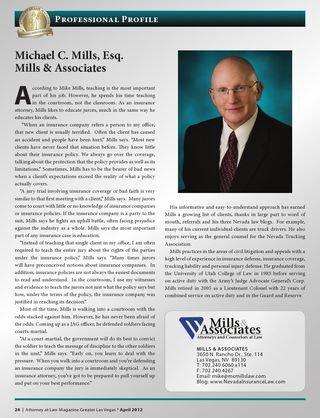In an earlier post HERE, we discussed a Nevada Supreme Court opinion where the court said that a claim for Breach of the Insurance Contract, and Bad Faith did not need to be brought in the same suit. However, based upon different facts, other courts have said that the Bad Faith and Breach of Contract suits must be filed in the same action. In the case of Sosebee v. State Farm Mut. Auto. Ins. Co., 164 F.3d 1215 (9th Cir. 1999), the court ruled that a Plaintiff, who brought a Breach of Contract and Bad Faith action could not bring a later second case.
In 1994, Ms. Sosebee was involved in an auto accident. She hurt her shoulder. There was a dispute between her and her carrier over whether the problems were caused by the accident or whether they were pre-existing. She filed suit and in September, 1996, Ms. Sosebee got a verdict against her insurance company for Breach of Contract and Bad Faith in her first suit. She tried to amend the complaint to add additional claims for ongoing Bad Faith but was denied.
After that verdict was rendered, she filed a second suit claiming that the carrier committed “post filing” Bad Faith. Ms. Sosebee didn’t like the fact that State Farm had hired a biomechanical expert as part of the processing of her earlier claim. The trial court told Ms. Sosebee, that she could not bring the second suit because the claim had already been decided by the first action.
The court said that Ms. Sosebee had the right to complain about the “post-filing” Bad Faith. The court acknowledged the prior Pulley case. However, the Court said that the Plaintiff did not properly protect her rights. The Ninth Circuit said that she should have appealed the decision of the trial court’s denial of her request to amend, rather than bring this second suit. The Ninth Circuit said:
While Nevada law may allow litigation of claims discovered after the first trial has already determined coverage and liability, it does not appear to allow piecemeal litigation of claims that were known or, in the exercise of reasonable discovery during litigation, should have been known while there was time to try all the claims in one trial.
The Nevada Supreme Court stated, and I agree, that the Pulley case was unique in its facts. I think that from an economy of justice standpoint, it is best to bring all the suits together in one action. Otherwise, if that first suit is over, Plaintiff seriously risks getting the second suit dismissed.
 Follow
Follow Email
Email



[…] For a different perspective with a different result, read our May 21, 2009 blog post by clicking HERE. […]